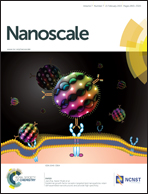Colloidal nanocrystals of orthorhombic Cu2ZnGeS4: phase-controlled synthesis, formation mechanism and photocatalytic behavior†
Abstract
The orthorhombic polymorph of Cu2ZnGeS4 (CZGS) is a metastable wurtzite-derived phase that can only be prepared in the bulk form by extensive heating at high temperatures (≥790 °C) when using the conventional solid-state reaction route. By employing a facile solution-based synthetic strategy, we were able to obtain phase-pure orthorhombic CZGS in nanocrystalline form at a much lower reaction temperature. Prior to this work, the colloidal synthesis of single-phase orthorhombic CZGS on the nanoscale has never been reported. We find that the use of an appropriate combination of coordinating solvents and precursors is crucial to the sole formation of this metastable phase in solution. A possible formation mechanism is proposed on the basis of our experimental results. Because CZGS consists of environmentally benign metal components, it is regarded as a promising alternative material to the technologically useful yet toxic cadmium-containing semiconductors. The orthorhombic CZGS nanocrystals display strong photon absorption in the visible spectrum and are photocatalytically active in dye degradation under visible-light illumination.


 Please wait while we load your content...
Please wait while we load your content...